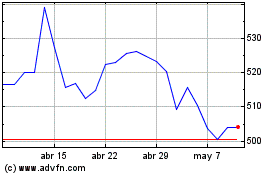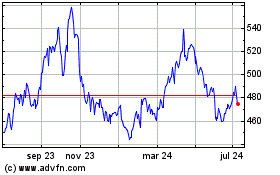By Sarah McFarlane
BP PLC has unveiled the most aggressive plans yet by a major oil
company to pivot toward cleaner energy. But the revamp has so far
failed to ignite enthusiasm among investors despite growing
interest in renewables.
The British energy giant's strategy -- the biggest overhaul in
its 111-year history -- calls for a 40% reduction in oil-and-gas
production over the coming decade, greater investment in low-carbon
energy and a ramp-up in wind and solar power. No other major oil
company has targeted such a steep decline in their main source of
profit.
"Our new strategy is going to transform BP into a very different
company, not overnight...but fast," new Chief Executive Bernard
Looney told investors this month at an event detailing the plans.
He acknowledged there were "a few concerns, some skepticism and
even a few myths" about the overhaul.
The 50-year-old BP lifer, who took the helm in February, said
the company would see its income from oil, gas and refining decline
after 2025, but that the reduction would be more than offset by
growth from gas stations, charging points and retail sites.
His comments came as BP issued a bleak outlook for oil, saying
demand could have already peaked and that it would potentially
never recover to pre-pandemic levels. Meanwhile, BP forecast
booming growth for renewable power.
The new strategy has so far failed to lift BP's shares out of an
industrywide slump exacerbated by the pandemic. The company's
shares remain stuck near a 25-year-low and have performed worse in
the past three months -- down 26% -- than those of peers Royal
Dutch Shell PLC and Exxon Mobil Corp.
BP investors say that while they are keen on renewables, they
are also concerned about the company's ability to execute its plans
without hurting profit. That's partly because of a lack of detail
as to how new operations will compensate for its shrinking oil
business, which is expected to remain its main source of profits
for years.
Analysts have also questioned how BP will perform in new fields
where it lacks experience and competition is rising. Moreover,
returns from renewables typically aren't as lucrative as fossil
fuels.
BP also faces the extra burden of a heavier debt load than most
of its peers at a time when the pandemic has sapped demand for oil,
hitting profit. That's prompted the company to slash its dividend,
write down the value of its assets and cut staff.
"Investors are arguably taking on more risk, and receiving less
reward," said Biraj Borkhataria, an analyst at RBC Capital
Markets.
BP gave a glimpse of what its future could look like earlier
this month when it agreed to pay $1.1 billion to Equinor ASA for
stakes in two U.S. offshore wind farms. It also launched a
partnership with the Norwegian energy company to pursue other
similar opportunities.
The deal is part of BP's plan to increase its investment in
low-carbon energy 10-fold to $5 billion a year by 2030, taking its
renewable-energy capacity to 50 gigawatts, from 2.5 GW in 2019.
Analysts say more deals will be needed to hit the target, like its
investment in solar business Lightsource.
BP also this month entered a partnership with Microsoft Corp.
under which it will supply renewable energy to the software maker
and work on initiatives to help cities reduce emissions. It hopes
to make money from selling such services and has already entered
arrangements with Houston and Scotland's Aberdeen.
Analysts say it isn't clear how significant these new businesses
will be to BP's earnings.
BP plans for 20% of its investments to focus on what it calls
transition businesses by 2025. That is up from about 3% last year
and more than its rivals.
The company acknowledges that its profit will continue to be
driven by fossil fuels in the coming years. It aims to achieve
returns of 8% to 10% from its low-carbon energy business, compared
with industry targets of around 15% for oil-and-gas.
"Oil prices are still the most significant driver of BP's
results and will be for the years to come," said RBC's Mr.
Borkhataria.
BP's strategy commits to returning 60% of any surplus cash to
investors via share buybacks, once it has reduced its debt to $35
billion from around $41 billion at June 30.
The company also plans to sell $25 billion of assets by 2025,
which it is around halfway to achieving, having recently sold its
petrochemical business to Ineos Ltd. for $5 billion.
"Getting their house in order through deleveraging is going to
be the most important priority ahead of executing strategy," said
Christyan Malek, an analyst at JPMorgan.
BP is one of the most indebted oil major oil companies, with
gearing -- the ratio of net debt to the total of net debt and
equity -- just below 38% including leases as at June 30, above its
targeted 20% to 30%.
Mr. Looney said BP hoped its revamp would appeal to a range of
investors, who are taking a greater interest in carbon reduction.
Oil stocks have fallen out of favor in recent years, while
companies focused on renewable energy have performed better.
This isn't the first time BP has tried to pivot away from oil
and gas. More than a decade ago, it rebranded as "Beyond Petroleum"
and committed to generating more renewable energy. After struggling
to make a profit, it sold or shut some operations and temporarily
stopped investing in alternative energy.
"The energy transition is a huge threat and opportunity for the
oil majors, but the odds are against them being successful," said
Cameron Hepburn, director of the Smith School of Enterprise and the
Environment, University of Oxford. "Most incumbent businesses
facing existential threats don't manage to successfully pivot."
Write to Sarah McFarlane at sarah.mcfarlane@wsj.com
(END) Dow Jones Newswires
September 29, 2020 14:13 ET (18:13 GMT)
Copyright (c) 2020 Dow Jones & Company, Inc.
Bp (LSE:BP.)
Gráfica de Acción Histórica
De Mar 2024 a Abr 2024

Bp (LSE:BP.)
Gráfica de Acción Histórica
De Abr 2023 a Abr 2024
